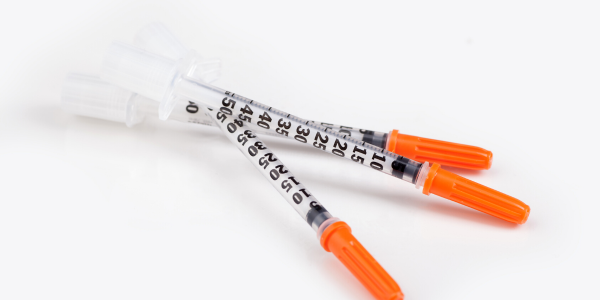
Semaglutide Versus Liraglutide for Weight Loss

Semaglutide and Liraglutide are a class of medications called GLP-1 agonists.
That means they mimic the effects of glucagon-like peptide-1.
GLP-1 is responsible for triggering the release of insulin and glucagon, which work together to control blood sugar. GLP-1 also slows the emptying of the stomach, which can lead to fewer cravings.
These medications perform similar functions, but there are differences between them. Read on to learn more about Semaglutide versus Liraglutide for weight loss.
Semaglutide Versus Liraglutide: Evidence of Weight Loss
Semaglutide appears to be more effective than Liraglutide in studies, though both offered statistically significant weight loss results.
In a direct comparison study, results showed that participants who received Semaglutide lost 15.8% of their total body weight in 68 weeks, compared to 6.4% with Liraglutide.
Another Semaglutide research study involved individuals who were obese but not diabetic. These participants were administered a weekly injection of Semaglutide, with a dosage of 2.4 mg, along with modifications to their lifestyle and diet.
The study revealed a 15% decrease in body weight, along with a reduction in cardiovascular and metabolic risk factors.
In contrast, the control group, which received a placebo and underwent similar lifestyle changes, experienced a weight loss of only 2.4% during the same period.
A research trial focusing on Liraglutide involved individuals without diabetes whose body mass index (BMI) was 30 or higher (27 if they also had hypertension or high cholesterol). Participants were administered 3 mg injections of Liraglutide on a daily basis.
Over the course of 56 weeks, the participants receiving Liraglutide experienced notable weight loss compared to the control group. The Liraglutide group also experienced a reduction in cardiovascular and metabolic risk factors, and insulin sensitivity improvement.
Semaglutide Versus Liraglutide: Blood Sugar Management
Semaglutide and Liraglutide both show benefit in managing blood sugar. GLP-1 agonists mimic the effects of GLP-1 to trigger the release of insulin and reduce the release of glucagon. Together, these hormones manage blood sugar.
Weight gain, an unhealthy diet, and other factors can lead to insulin resistance. This means insulin becomes less able to remove glucose from the bloodstream and deliver it to the cells for energy.
Insulin resistance leads to high blood sugar, which can in turn lead to obesity, diabetes, heart disease, and other chronic conditions if left untreated.
Semaglutide has shown efficacy in managing blood sugar and may potentially work better than other GLP-1 agonists.
Liraglutide has also shown benefit in managing blood sugar through similar means.
Semaglutide Versus Liraglutide: Dosage and Frequency
Semaglutide is a once weekly subcutaneous injection. The medication is titrated, or started at a lower dose and increased over time to help the body adjust.
Dosages range from 0.25 mg to 2 mg. Semaglutide is typically increased by 0.25 mg every four weeks until patients reach the maximum dose.
Liraglutide is a once-per-day subcutaneous injection. This medication is also titrated, and the starting dose is typically 0.5 mg. It’s increased by 0.5 mg every week until reaching the maximum dosage of 2.5 mg.
The biggest difference between Semaglutide and Liraglutide is the frequency: once per week compared to once per day. The best option for you depends on your comfort with injections, and whether daily injections are feasible for you.
Semaglutide Versus Liraglutide: Injection Experience
Semaglutide and Liraglutide are injected in the same way: subcutaneously using a small insulin syringe.
Subcutaneous injections are typically more comfortable for patients than intramuscular injections, with minor pain and little site irritation.
We recommend that you rotate injection spots to avoid fatigue in one area. This is especially necessary with Liraglutide, which is injected daily.
Injection sites for Liraglutide and Semaglutide include:
- Upper arms
- Abdomen
- Thighs
Defy Medical offers access to injection supplies like syringes, alcohol wipes, and sharps containers. You can add these supplies easily to your medication order (if prescribed).
Semaglutide Versus Liraglutide: Access
Many patients prefer Semaglutide over Liraglutide, because it’s injected less frequently and has shown better outcomes with blood sugar management and weight loss in medical studies.
However, Semaglutide is currently under shortage, and access can be limited. Liraglutide does not have these same issues with access and is currently available for most patients.
GLP-1 agonists are tools patients can use under the guidance of a provider to pursue weight loss and positive changes in body composition. If a GLP-1 agonist is right for you, then it’s important to choose one you can reliably access.
Defy Medical currently offers access to both medications along with other GLP-1s, and we keep patients informed and aware of any issues with supply.

Semaglutide and Liraglutide at Defy Medical
The right medication for you depends on many factors, but this article lays out the general differences between Semaglutide and Liraglutide.
When you book a Weight Management consultation with Defy Medical, you’ll be able to discuss your options in-depth, ask questions, and build an individualized plan based on your needs.
Ready to learn more?
Get Started

